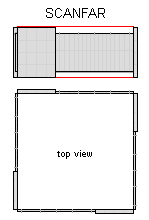Difference between revisions of "Hughes SCANFAR"
Acelanceloet (talk | contribs) |
Acelanceloet (talk | contribs) m (→History) |
||
| Line 4: | Line 4: | ||
The SCANFAR was the first phased array radar system deployed by the US Navy. It was installed on CGN-9 and CVN-65. The system consisted of the [[AN/SPS-32]] air surveillance radar and [[AN/SPS-33]] target tracking radar. The system was commissioned in 1961, onboard the CVN-65. The system did not work satisfactory, and was removed from the Enterprise in 1979 and from the Long Beach around 1985. In both cases the system was replaced by SPS-48, the ships remained in active service. | The SCANFAR was the first phased array radar system deployed by the US Navy. It was installed on CGN-9 and CVN-65. The system consisted of the [[AN/SPS-32]] air surveillance radar and [[AN/SPS-33]] target tracking radar. The system was commissioned in 1961, onboard the CVN-65. The system did not work satisfactory, and was removed from the Enterprise in 1979 and from the Long Beach around 1985. In both cases the system was replaced by SPS-48, the ships remained in active service. | ||
| − | The SCANFAR was based on technology developed for the Typhon program. Where the SPG-59 of Typhon did all the tasks a radar could do, on SCANFAR the tasks of search and targeting being split between 2 antenna's and the actual target illumination being left to existing missile directors. Even with the simplification, the system proved to be beyond state of the art, the large amount of broadcasting elements proved to be unreliable and expensive. In 1967, an automatic tracking computer was added to the setup. The vulnerable vacuum tubes of the system were replaced by solid state electronics on CGN-9 during an overhaul in 1967. This lightened the superstructure by 20 tons. | + | The SCANFAR was based on technology developed for the [[Typhon]] program. Where the [[SPG-59]] of Typhon did all the tasks a radar could do, on SCANFAR the tasks of search and targeting being split between 2 antenna's and the actual target illumination being left to existing missile directors. Even with the simplification, the system proved to be beyond state of the art, the large amount of broadcasting elements proved to be unreliable and expensive. In 1967, an automatic tracking computer was added to the setup. The vulnerable vacuum tubes of the system were replaced by solid state electronics on CGN-9 during an overhaul in 1967. This lightened the superstructure by 20 tons. |
| − | The capabilities of the system were very good, having even over the horizon capabilities. The experience gained with SCANFAR were applied to the SPY-1 radar of the AEGIS system. | + | The capabilities of the system were very good, having even over the horizon capabilities. The experience gained with SCANFAR were applied to the SPY-1 radar of the AEGIS system. |
== Used on == | == Used on == | ||
Revision as of 01:05, 11 February 2018
History
The SCANFAR was the first phased array radar system deployed by the US Navy. It was installed on CGN-9 and CVN-65. The system consisted of the AN/SPS-32 air surveillance radar and AN/SPS-33 target tracking radar. The system was commissioned in 1961, onboard the CVN-65. The system did not work satisfactory, and was removed from the Enterprise in 1979 and from the Long Beach around 1985. In both cases the system was replaced by SPS-48, the ships remained in active service.
The SCANFAR was based on technology developed for the Typhon program. Where the SPG-59 of Typhon did all the tasks a radar could do, on SCANFAR the tasks of search and targeting being split between 2 antenna's and the actual target illumination being left to existing missile directors. Even with the simplification, the system proved to be beyond state of the art, the large amount of broadcasting elements proved to be unreliable and expensive. In 1967, an automatic tracking computer was added to the setup. The vulnerable vacuum tubes of the system were replaced by solid state electronics on CGN-9 during an overhaul in 1967. This lightened the superstructure by 20 tons.
The capabilities of the system were very good, having even over the horizon capabilities. The experience gained with SCANFAR were applied to the SPY-1 radar of the AEGIS system.
Used on
- CGN-9 Long Beach 1961
- CVN-65 Enterprise
Affiliated systems
Part description
The part has a sideview (which also serves as front view) and an top view drawn. Red lines show the minimal deckhouse size required to mount the radars and affiliated systems behind it.
